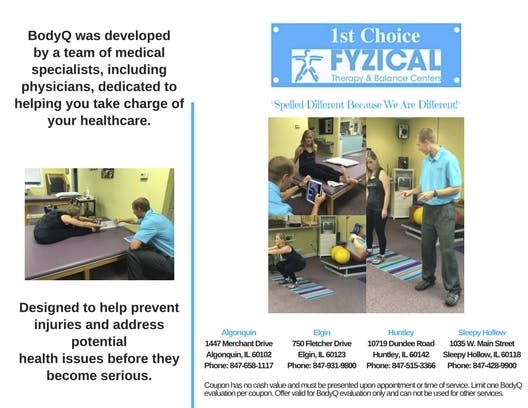
A 66-year-old woman who loves to golf went to her local Physical Therapy and Balance Center to assess her physical condition. Her goal was to improve her game. Her BODYQ assessment quickly revealed the root of the problem: weak core muscles.
Because BODYQ could quickly assess her exact issue, her fitness expert could design a custom core strengthening program ideal for her needs. The Result? A month later her golf ball soared another 25 yards.
GET FURTHER, FASTER
You might be thinking that any experienced personal trainer could figure out that core strength is crucial to playing golf. While that is true in broad terms, it takes some trial and error to determine which core muscles need what. It’s not just about your abdominals-core muscles include shoulders, back and hips, too. This complex muscular network has to be balanced in strength and flexibility.
BODYQ provides Physical Therapy & Balance Centers physical thearpists and fitness experts with an unprecedented assessment tool to develop the ultimate customized exercise routines for an individuals’ specific body.
Mike Drumm, MS, CSCS, is a highly experienced exercise physiologist who specialized in strength and conditioning. He’s worked with dozens of clients at the Ft. Meyer’s Florida location. He credits BODYQ for enabling him to more efficiently develop effective exercise programs.
“It’s common for personal trainers with little medical training to need several sessions to figure out a client’s true strengths and weaknesses,” says Drumm. “With BODYQ, we know in about 45 minutes.”
Exercise programs are not only designed around clients’ goals and needs, they are also designed around where they exercise and what exercise equipment they use. For example, fitness experts could design a home-based program using hand weights and flexible tubing or the program can be based around gym equipment. “Ideally, we check BODYQ scores every six months,” explains Drumm. “That way, we can see if the scores went up or down and then further customize the exercise routine as needed.”
INVENTED BY MEDICAL EXPERTS
Several years ago, Jim Abrams, was told he needed knee surgery because of an old sports injury. He went to physical therapy, which corrected muscular imbalances. Not only was he spared from knee surgery; the process relieved decades-old back and neck pain.
That experience led Abrams to join a team of inventors who created the BODYQ system.
“A lot of people ignore aches and pains hoping they’ll go away or think it’s just a part of aging,” says Dan Deems MD, PhD, FACS. “With BodyQ we can identify looming musculoskeletal problems, correct balance challenges, and identify ailments that you can reverse so you can live a higher quality of life.”
BODYQ IS A COMPREHENSIVE SCREENING PROGRAM
BODYQ analyzes your muscle strength, endurance, flexibility,k range of motion, vision, hearing and balance in a single testing session. The results and recommendations are immediate–no need to wait for days or weeks.
BODYQ also calculates an all important baseline score. Your score is compared to others of your age and gender. It’s insightful and motivating to know how you rank relative to others.
Cheryl Rapp, a woman in her mid-50’s, has a regular routine of working out five days a week but wanted to take her fitness to the next level. She was amazed by what BODYQ revealed.
I was tripping occasionally and I just blamed it on my flip-flops,” said Cheryl, “The big surprise was that my ankle flexibility was about half of what it should have been.”
Other revelations about strengths and weaknesses inspired a whole new workout routine for Rapp. Another woman in her early 60s was looking to start a fitness program. But BODYQ showed she was a fall risk. So, she was referred to a Physical certified balance therapist with whom she could safely develop her muscles and then transition into a customized excercise program.
AN OUNCE OF PREVENTION
Many people have determined that preventative care, which includes training with a fitness expert and physical assessment with BODYQ, is ultimately less expensive and more life-enhancing than spending money on conventional medical care for preventable health problems. Whether you want to increase your energy levels, recover from injury or illness, run your first 5K, lose 10 pounds or just feel stronger, BODYQ can jump-start your efforts.


